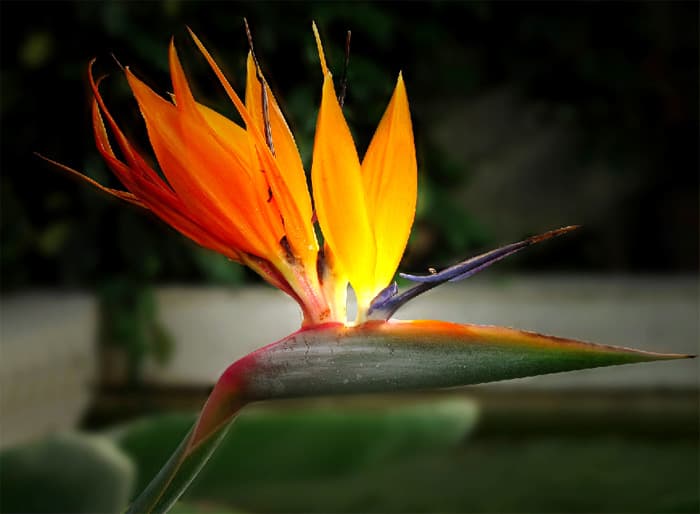Very colourful, tall plants.
Large plants produce spectacular flowers of bright orange and rich blue in early summer. Exotic, bird-like blooms.
GP - Greenhouse perennial. Height 90-150 cm.
CULTURE: Sow at any time under glass. Germination is sporadic from 90 days. May take several years to bloom.
HINTS: Ideal as pot plants for glasshouse or home. Prefers full sun or partial shade.
Agrotechnics: prefers a bright, sunny place, but protected from direct sunlight.
Growing strelitzia from seeds is a complex process that takes time and patience.
Sowing all year round. Before sowing, the seeds are soaked for 12 hours in warm water at a temperature of + 20 + 22 ° C. Planting depth is 0.5-1 cm. At a temperature of +24+25°C, shoots appear in 30-40 days. Seedlings dive several times and only in the second year are planted in a permanent place. The plant blooms for 4-5 years. In winter, keeping in a cool place is recommended. In the summer, top dressing is carried out every two weeks with flower fertilizer.
Flowering: February-July.

Bird of paradise, crane lily, crane flower.
Strelitzia seeds lose their germination capacity very quickly, so as soon as you get them, plant them immediately. You need to tear off the orange fuzz, then gently rub the seeds with fine sandpaper or a nail file to scratch the thick outer skin. Then soak them overnight in hot water (+30+40°C), adding 5 drops of a complex fertilizer to it. Alternatively, soak for two days in plain water, then for one day in a weak solution of potassium permanganate, and for another day in "Epin".
It is best to plant in pure, damp sand. Do not bury them deeply - press them into the soil so that the small black part of the seed remains visible. Germinate the seeds in a dark, warm place (+25+30°C), keeping the sand moist. If you provide bottom heat, the seeds germinate in about four weeks.
One week after planting, start inspecting the seed daily - as soon as any convexity or swelling becomes noticeable, carefully transplant the seed into a mixture of peat and sand in equal proportions. From this moment on, the seed constantly needs fresh air, otherwise it will produce a root but not a sprout, and the root may simply rot without fresh air.
But remember that Strelitzia seeds can germinate from one month to one year, so you should not rush to dig them up.
In the future, it is advisable to provide the young plant with supplemental lighting in winter and обязательно keep it warm during the first year of life (about +25+27°C). Strelitzia grown from seeds blooms in four years.
* Strelitzia reginae (Strelitzia reginae) - a South African flower that has captivated the whole world with its beauty and exotic shape, received its generic and specific name in honor of the English Queen Charlotte Sophia, née German Duchess of Mecklenburg-Strelitz.
This is an evergreen plant, representing a lush bush up to 2 m in height and sometimes exceeding 1.5 m in lower diameter, with beautiful, wavy-edged, dark green, banana-like oblong-elliptical leaves (blade length about 50 cm, width up to 20 cm) on long, sturdy petioles, growing from a short underground trunk. The unique, somewhat almost artificial-looking, bright, scentless flowers of Strelitzia, which are axillary inflorescences with purple-blue petals, orange sepals, and partial inflorescences-curls in boat-shaped, tightly folded, green with red tops, leathery bracts (beak-like spathe), rising on a long, sturdy peduncle, resemble in shape the head of a crested crane or a bird of paradise, for which the plant received its common name - Bird of Paradise (Paradise Bird - English, Flor pajaro - Spanish, Arg.).
Among other members of the Strelitziaceae family, Strelitzias are most highly adapted for pollination by birds, mainly sunbirds. The flowers even have a special spring mechanism - an arrow-like organ formed by vertically standing petals and sepals that clamp an elastic column of 5 long stamens, which shoots pollen onto the breast of a bird that has landed on the inflorescence.
They prefer a humid climate and moderately moist, loose, slightly acidic, nutritious soil with good drainage. They are quite undemanding to light: they develop well in partial shade, dappled shade, and in open areas with direct sunlight. When keeping Strelitzias in indoor conditions, due to their large size (especially Strelitzia nicolai), they are more suitable for large rooms or greenhouses than for ordinary apartments. In temperate climates, in greenhouse and indoor conditions, Strelitzia reginae usually blooms from late winter - early spring - until the end of summer, and Strelitzia nicolai - in winter-spring, from January to May-June.
In indoor culture, plants require good light, frequent spraying to create high humidity, periodic feeding, and cooler maintenance in winter, similar to subtropical plants (temperature 14-18 degrees) with reduced watering. Since the plants are wind-resistant, in summer it is advisable to keep them outdoors, on a balcony or loggia. In the humid winter climate of Buenos Aires, Strelitzias tolerate short-term nighttime temperature drops to 0 degrees well.
In regions with subtropical and tropical climates, Strelitzias are most often propagated by division, separating the suckers that have sprouted from the mother plant, in late winter or early spring.
Strelitzias are slow-growing plants, so flowering of a young plant can most often be expected no earlier than in 1-2 years.
Seed propagation is complicated by the rather long germination period - from 1 to 6 months or even more, and most importantly - the long wait for the first flowering: for Strelitzia reginae - at least 3-4 years under favorable conditions, and for tree-like Strelitzias - 6-8 years. Before sowing in sandy soil, seeds are soaked for one to two days in water, but it is better to soak them in a solution of phytohormones to accelerate germination. The seeds must be fresh, as they begin to lose viability if not sown approximately six months after ripening.
It is recommended to clean fresh seeds from the orange hairy arils and, after soaking in a phytohormone, plant them in the soil at a depth 1.5 times the size of the seed. During germination, maintain a constant temperature of 25 degrees, at which seedlings appear within 4-8 weeks (lower temperatures delay the process). The first transplant into well-drained soil is done in the phase of 2-3 leaves; further repotting of growing specimens - depending on the filling of the pots with roots, without waiting for very tight root binding, which can negatively affect the growth rate. Young plants must be protected from direct sunlight.












